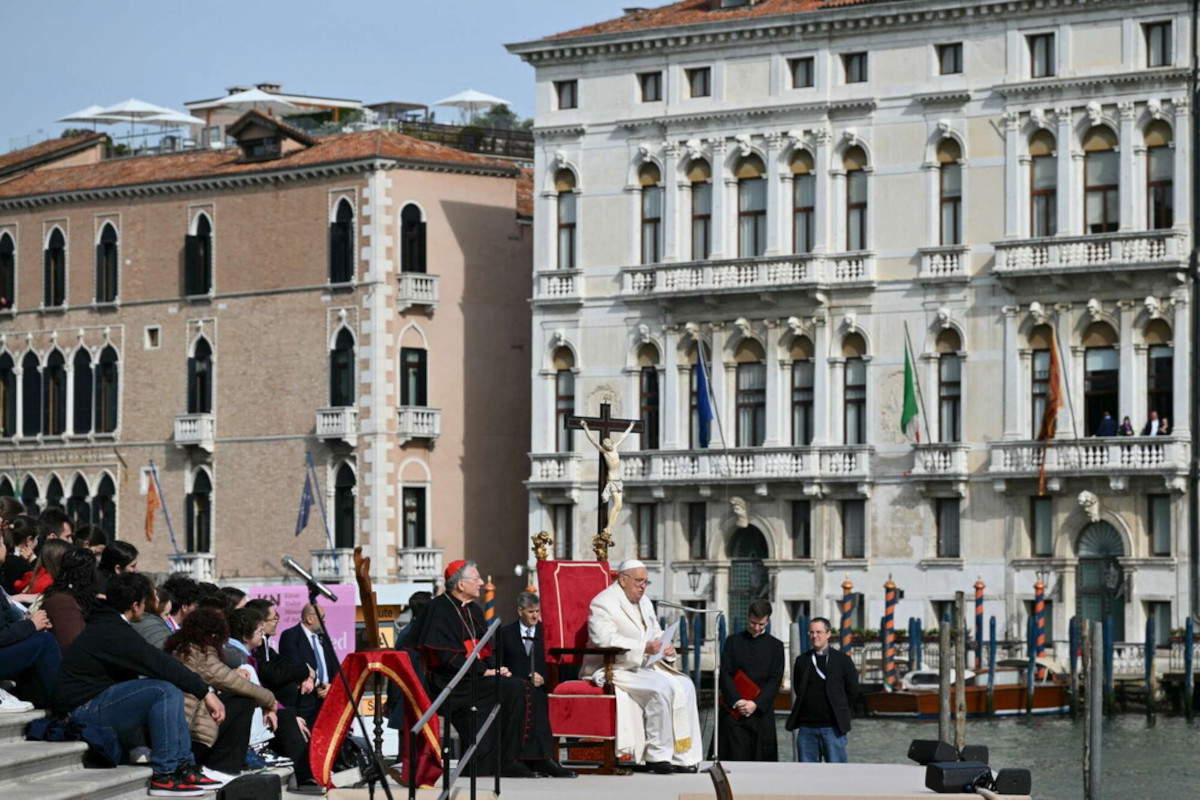For the first time in history, a pontiff is visiting the Venice Biennale: in fact, Pope Francis arrived this morning by helicopter in the Lagoon, where he first met with the female inmates of the Giudecca prison and then visited the Holy See Pavilion, set up precisely in the Giudecca women’s detention house. Here the exhibition titled With My Eyes presents works by eight artists (Maurizio Cattelan, Bintou Dembélé, Simone Fattal, Claire Fontaine, Sonia Gomes, Corita Kent, Marco Perego & Zoe Saldana, Claire Tabouret), dealing with the theme of human rights and to the figure of the last, a central pivot of Pope Francis’ Pontificate.
“Prison is a harsh reality, and problems such as overcrowding, lack of facilities and resources, and episodes of violence, generate so much suffering there,” the pontiff said, later urging in his speech to “not take away dignity from anyone” and stressing that prison “can also become a place of rebirth, both moral and material, where the dignity of women and men is not ’put in isolation,’ but promoted through mutual respect and the nurturing of talents and abilities.” “I wished to meet you at the beginning of my visit to Venice to tell you that you have a special place in my heart. Therefore, I would like us to live this moment not so much as an ’official visit’ of the Pope, but as a meeting in which, by God’s grace, we give each other time, prayer, closeness and fraternal affection. Today we will all come out of this courtyard richer, perhaps the one who will come out richer will be me, and the good we will exchange will be precious,” said the Pope speaking to the inmates, who gave the Holy Father some of the products they make in the prison workshops.
Pope Francis then met with some artists, “The world needs artists. This is demonstrated by the multitude of people of all ages who attend art places and events,” he emphasized. “I confess that next to you I do not feel like a stranger: I feel at home. And I think this actually applies to every human being, because, for all intents and purposes, art holds the status of a ’city of refuge,’ a city that disobeys the regime of violence and discrimination to create forms of human belonging capable of recognizing, including, protecting, embracing everyone. Everyone, starting with the last ones.” He then called on art to network, “working together to rid the world of senseless and now hollowed-out antinomies, but which seek to take over in racism, xenophobia, inequality, ecological imbalance and aporophobia, this terrible neologism meaning ’phobia of the poor.’ Behind these antinomies there is always the rejection of the other. There is the selfishness that makes us function as solitary islands instead of collaborative archipelagos.” “I implore you, fellow artists, imagine cities that do not yet exist on the map: cities where no human being is considered a stranger. That is why when we say strangers everywhere, we are proposing brothers everywhere,” he concluded.
“It is true that no one has a monopoly on human pain. But there is a joy and suffering that are united in the feminine in a unique form and that we must listen to, because they have something important to teach us. I think of artists like Frida Khalo or Louise Bourgeois and so many others,” he then said addressing the artists. “I hope with all my heart that contemporary art can open our gaze, helping us to properly value the contribution of women, as co-protagonists of the human adventure.”
After the stop at the Holy See Pavilion, the pope went to the Basilica della Salute to meet with the youth of the diocese. “In addition to being beautiful, we are fragile, and the two things go together: a bit like Venice, which is beautiful and delicate at the same time. That is, it is beautiful and delicate, it has some fragility that needs to be taken care of,” he said in his address to the youth. “Venice itself tells us that only by rowing steadily can we go far. If you are Venetian citizens, learn to row steadily to go far. Of course, rowing requires regularity; but constancy rewards, even if it costs effort,” the pontiff concluded.
The pontiff then left the Basilica della Salute, crossed the Grand Canal and then went to St. Mark’s Square where he said Mass. “If today we look at this city of Venice, we admire its enchanting beauty, but we are also concerned about the many issues that threaten it,” he said before the faithful. “Climate change, which has an impact on the waters of the Lagoon and on the territory; the fragility of buildings, cultural heritage, but also that of people; the difficulty of creating an environment that is on a human scale through adequate management of tourism; and also all that these realities risk generating in terms of frayed social relations, individualism and loneliness.”
Afp photo



 |
| Pope Francis at Venice Biennale: first time in history for a pontiff |
Warning: the translation into English of the original Italian article was created using automatic tools. We undertake to review all articles, but we do not guarantee the total absence of inaccuracies in the translation due to the program. You can find the original by clicking on the ITA button. If you find any mistake,please contact us.